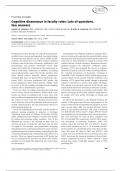F E L LO W S C O LU M N
Cognitive dissonance in faculty roles: Lots of questions,
few answers
Joellen W. Hawkins, RNC, WHNP-BC, PhD, FAAN, FAANP (Professor) & Holly B. Fontenot, RN, WHNP-BC
(Clinical Assistant Professor)
William F. Connell School of Nursing, Boston College, Chestnut Hill, Massachusetts
Column Editor: Sue Leight, EdD, CNCS, C-ANP
Correspondence: Joellen W. Hawkins, RNC, WHNP-BC, PhD, FAAN, FAANP, William F. Connell School of Nursing, Boston College, 140 Commonwealth
Avenue, Chestnut Hill, MA 02467. Tel: 617-552-4252; Fax: 617-552-0745; E-mail: hawkinsj@bc.edu
doi:10.1111/j.1745-7599.2008.00322.x
During the past three decades, the roles of nursing faculty To paraphrase the Wikipedia definition, cognitive disso-
members have evolved and expanded. In a typical college nance is a term used to describe the uncomfortable tension
or university that operates on the tenure model, faculty that may arise from having two conflicting demands at the
members are expected to be excellent teachers; produce same time or from demands to engage in activities that
scholarly work in the form of research, publications, and conflict with one’s beliefs, creating a ‘‘perception of incom-
presentations; and perform community service both patibility between two cognitions’’ (Wikipedia, 2007).
within and outside the institution in the professional as Festinger (1957) first proposed the theory of cognitive
well as in the larger community. In addition, accrediting dissonance based on research studies involving individu-
and certifying bodies expect that faculty members who als’ reported perceptions of dissonance (Festinger &
teach clinical courses maintain clinical competence Carlsmith, 1959). Aaronson (1969) linked cognitive dis-
(National Task Force on Quality Nurse Practitioner Edu- sonance theory to self-concept. Tedeschi, Schlenker, and
cation, 2002). For nurse practitioner (NP) faculty, this Bonoma (1971) argued that people attempt to maintain
means engaging in direct clinical practice. Adding ‘‘walk cognitive consistency to protect their public self-image.
on water’’ to the list would be redundant because juggling This linkage is particularly relevant to NP faculty who
all these roles is probably the equivalent. might identify themselves primarily as clinicians, mentors,
To be sure, there are colleges and universities with dual and teachers rather than as researchers and scholars. This
tenure tracks: clinical and research. Where these exist, private self-image of NP faculty members might then be
faculty can choose to emphasize one or more roles, with in conflict with their public self-image of scholar and
lesser or different emphasis on the others, depending upon researcher.
the criteria for each track. The dilemma becomes more To add to the dissonance is the disparity between the
acute when the criteria for promotion and tenure do not salaries of NPs practicing full time and prepared at the
include clinical practice, but the professional criteria for master’s or doctoral level and NP faculty members. Accord-
educational programs do. ing to recent salary data, the median full-time faculty
Given the shrinking pool of faculty and the growth of salary at the assistant professor rank with a doctorate
graduate nursing programs in response to shortages was $68,444 and with a master’s degree $58,567 (based
(American Association of Colleges of Nursing [AACN], on a calendar year for comparison with clinical positions).
2007), administrators have begun to examine new models The 75th percentile for each of these categories was
for hiring and retaining faculty members. One of the $73,333 and $64,590, respectively (AACN, 2005; Ameri-
dilemmas for faculty is the demand on their time for can Association of University Professors, 2007). The
activities they are rewarded for and those they are paid median salary for full-time NPs was $74,015. Because
to engage in. For example, class preparations, arranging most faculty members are on a 9- or 10-month contract,
clinical placements, and making clinical site visits consume faculty salaries are considerably lower than those of clini-
significant amounts of time for faculty, especially given the cians. The mean NP salary in 2007 was $74,015, with
constantly changing body of knowledge and evidence for a range well over $100,000 (Nurse practitioner salary data,
practice. These are typical expectations of NP faculty but 2007). Data from the American Academy of Nurse Practi-
are not necessarily the activities for which most faculty tioners Compensation Survey (2007) reported a mean
members are rewarded. This dichotomy can create cogni- annual base salary of $86,486 among a total of 7832
tive dissonance. practicing NPs.
Journal of the American Academy of Nurse Practitioners 20 (2008) 289–290 ª 2008 The Author(s) 289
Journal compilation ª 2008 American Academy of Nurse Practitioners




